The Toolik ornithologists are interested in how birds cope with the Arctic and how this coping mechanism will adjust as the Arctic changes as a result of climate change. Some of the researchers are interested in the impact of climate change on the seasonality of bird migratory patterns. Birds usually use the light to tell them when to migrate and when to breed and the researchers want to know how a change of temperature will affect their food availability here in the Arctic. They have many techniques to follow and comprehensively study the birds that are mentioned below. This includes performing transect surveys, putting on bird tags, doing nest checks, following birds with radio transmitters, doing bug surveys, monitoring environmental conditions, setting up mist netting, and more. Their project is multitrophic and encompasses plants, bugs, and birds.
Why should birds migrate to higher latitudes?The Arctic is a very extreme environment with constant fluxes in temperature and weather but constant light. The main reasons are:
- Reduced predation
- Longer days to feed offspring
- Reduced parasites
- Decreased interspecies competition
- Predictable season increase in food resources
If you want more information about specific Arctic birds- go here: http://toolik.alaska.edu/edc/biotic_monitoring/index.php
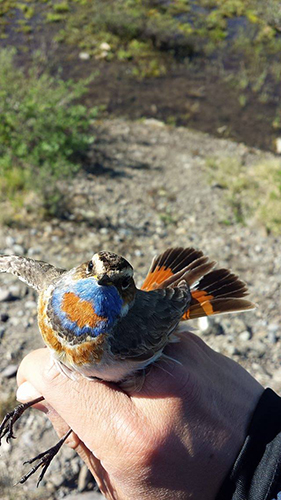 Blue-throat. Photo by Jeffrey Cheah
Blue-throat. Photo by Jeffrey Cheah
 Yellow Warbler. Photo by Jeffrey Cheah
Yellow Warbler. Photo by Jeffrey Cheah
Gull eating an Arctic ground squirrel
Arctic Tundra bird adaptationsCold Weather Survivalists
For some birds, like the Redpolls, their extra-fluffy feathers help keep the small birds warm in the extreme cold. If they get too warm, hoary redpolls sometimes pluck out feathers to cool off; the feathers can grow back in just a few days.
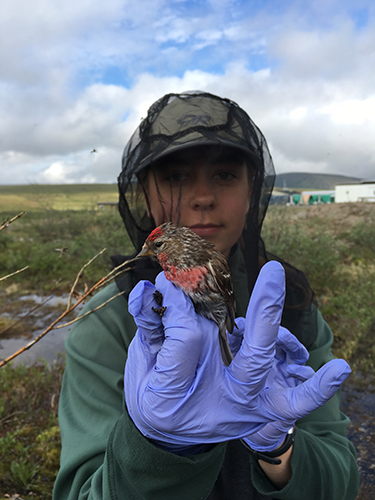 Caroline Newell with a Redpoll that was caught in mist nets. Photo by DJ Kast
Caroline Newell with a Redpoll that was caught in mist nets. Photo by DJ Kast
Camouflage
A few birds like ptarmigans are adapted to stay on the tundra all year long. They blend into the landscape in the winter with a beautiful white coat and in the summer they molt to a brownish color to blend into the surrounding tundra plants.
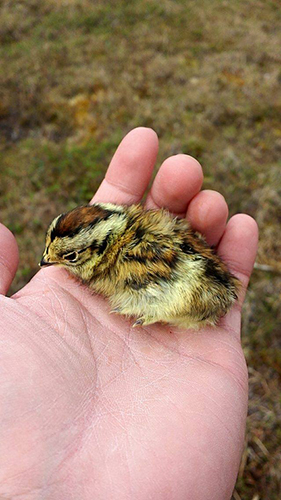 Baby Ptarmigan. Photo by Jeffrey Cheah
Baby Ptarmigan. Photo by Jeffrey Cheah
Ground nests
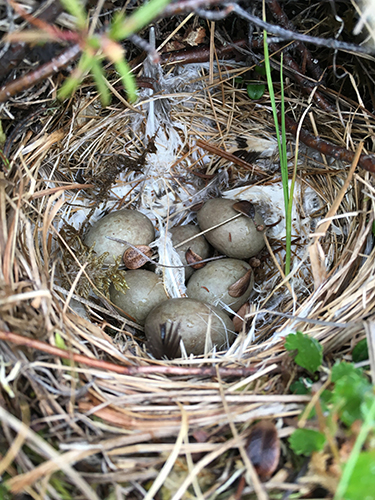 Lapland Longspur eggs in a nest. Photo by DJ Kast
Lapland Longspur eggs in a nest. Photo by DJ Kast
Many of the birds that lay eggs in the Arctic place their nests close to the ground and usually at the bases of tussocks. They camouflage very well and difficult to see.
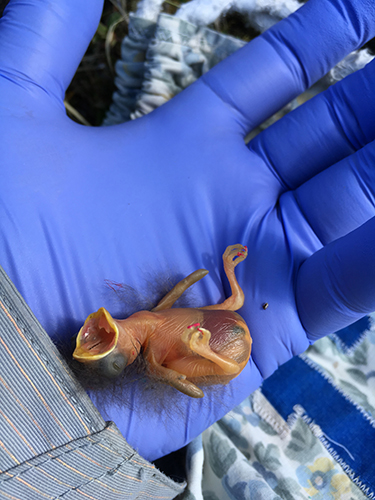 Baby Gambel's white-crowned sparrow. Photo by DJ Kast
Baby Gambel's white-crowned sparrow. Photo by DJ Kast
Babies and Food Availability
Arctic birds have one clutch or one set of baby birds and that is because of the food that is available.
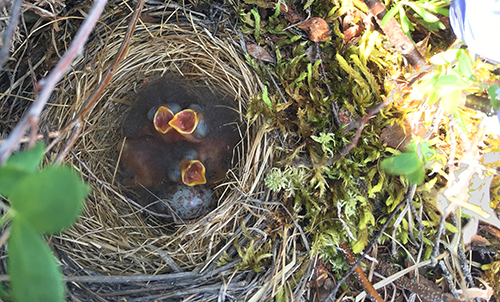 Nest of 3 Gambel's white-crowned sparrow babies in a nest near Toolik Field Station. Photo by DJ Kast
Nest of 3 Gambel's white-crowned sparrow babies in a nest near Toolik Field Station. Photo by DJ Kast
Climate change will affect this in two ways. One the light isn’t changing and many of them know to travel to the Arctic when the suns angle reaches a certain point. Warmer weather earlier in the year would mess with the season pattern of food availability, for example having the bugs that are temperature driven come out earlier and could be less available to the birds when they do arrive. Furthermore, climate change is predicted to increase the extreme weather like snow in June/July which will kill a lot of the clutches.
People: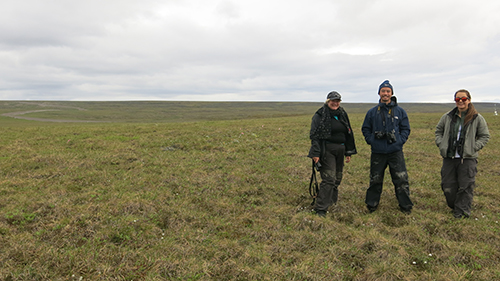 Bird research team including Dr. Simone Meddle, Jeffrey Cheah, and Caroline Newell. Photo by DJ Kast
Bird research team including Dr. Simone Meddle, Jeffrey Cheah, and Caroline Newell. Photo by DJ Kast
- John Wingfield
- Dr. Simone Meddle
- Helen Chmura
- Jesse Krause
- Jeffrey Cheah
- Caroline Newell
Bird backpacks and transmitters
The Toolik Ornithologists place backpacks with radio transmitters on them to be able to track them around the Arctic tundra environment.
Identifying bracelets for individuals and sex (female/male).
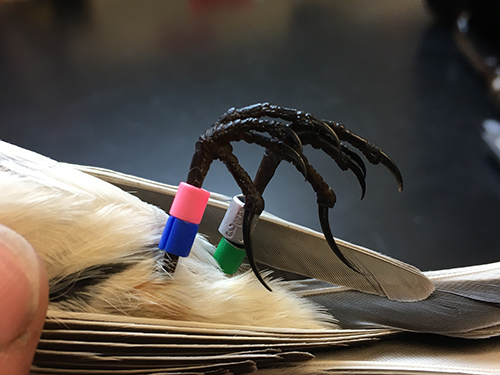 Lapland Long Spur with ID tags on it. Photo by DJ Kast
Lapland Long Spur with ID tags on it. Photo by DJ Kast
- Left foot- white over aluminum - male; white over red- female.
- Right foot- identifying patterns - varying combinations of colors.
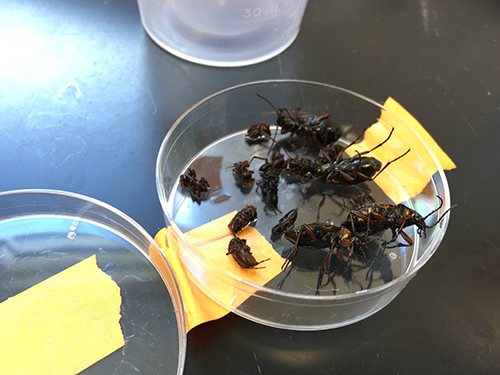 Petri-dish of bugs collected from pit falls. Photo by DJ Kast
Petri-dish of bugs collected from pit falls. Photo by DJ Kast
Bug surveys are used to assess the food availability for the birds. There are two methods used to collect bugs. Sweep net sampling collects the “canopy” bugs from the leaves and branches of the tundra plants. Pitfall sampling uses cups with ethanol that are placed into the ground so that bugs fall in and die. The pitfalls are used to collect ground dwelling bugs and arthropods. The bugs are then dried in a drying oven and weighed to calculate the biomass of available food.
 Jeffrey Cheah holding a crane fly. Photo by DJ Kast
Mist nets
Jeffrey Cheah holding a crane fly. Photo by DJ Kast
Mist nets
Many of the birds are tracked year to year and are caught using these mist nets. The nets are placed low to the ground because their nests and territories are in and around the tussocks. This year the ornithologists were looking at two types of birds: Lapland long spur and White crowned sparrow. Playback calls are played to entice certain birds to leave their nests and hopefully land in the mist netting so they can be measured and analyzed.
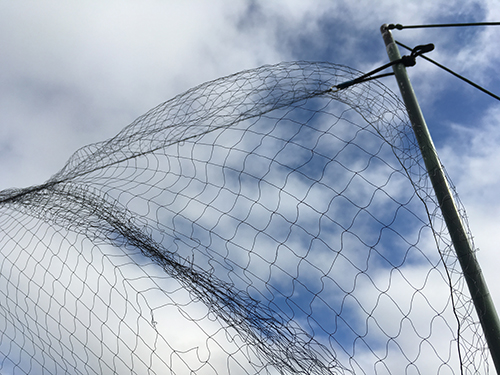 Photo of the mist netting that the bird researchers were using. Photo by DJ Kast
Photo of the mist netting that the bird researchers were using. Photo by DJ Kast
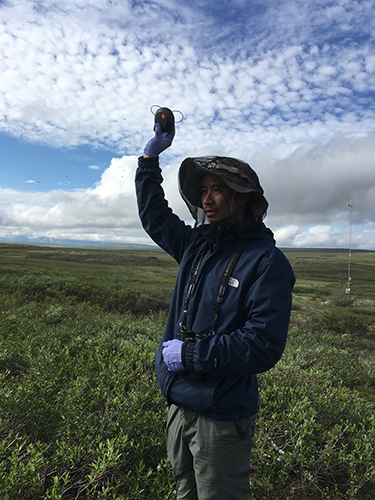 Jeffrey Cheah with the playback speakers. Photo by DJ Kast
How to find nests.
Jeffrey Cheah with the playback speakers. Photo by DJ Kast
How to find nests.
The bird research team finds nests by walking for miles and checking the bottom of tussocks. Most of the nests of the Arctic Tundra are in the ground and nest materials come from lots of various sources like moss, grass, other bird feathers, and caribou fur. For example, the Lapland Long Spurs love the tussocks and they use ptarmigan feathers to line their nests. Their eggs are gray in color and sometimes speckled.
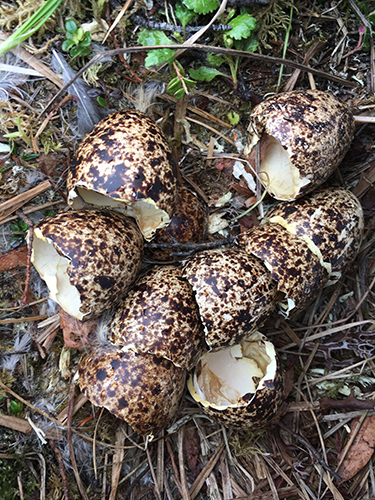 Hatched Ptarmigan eggs in a nest near Toolik. Photo by DJ Kast
Hatched Ptarmigan eggs in a nest near Toolik. Photo by DJ Kast
Once found there are three nest markers placed and they are indicative of distance away from the nest. - Green, pink, orange (Green is the closest- .5 m, orange 5 m, pink 10 m) Then a tongue depressor is placed on the tussock that the nest is buried into with an identification marker.
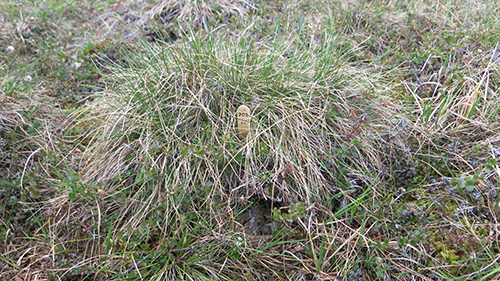 The underground nest in the tussocks which the researchers ID-ed with a tongue despressor. Photo by DJ Kast
The underground nest in the tussocks which the researchers ID-ed with a tongue despressor. Photo by DJ Kast
When birds do hatch, the researchers go back every few days to take measurements on the nestlings such as beak and skull size. If there are multiple their nails are painted so that the researchers know which one is which.
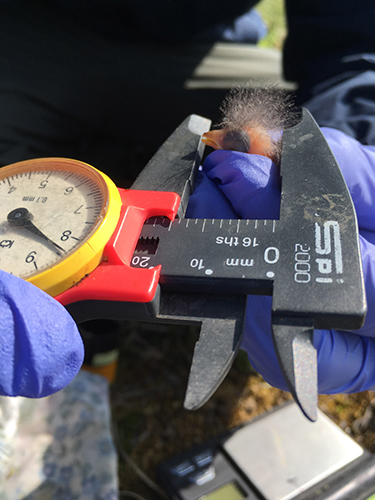 Jeffrey Cheah measuring the skull of a baby bird. Photo by DJ Kast
YSP Flags with Birds
Jeffrey Cheah measuring the skull of a baby bird. Photo by DJ Kast
YSP Flags with Birds
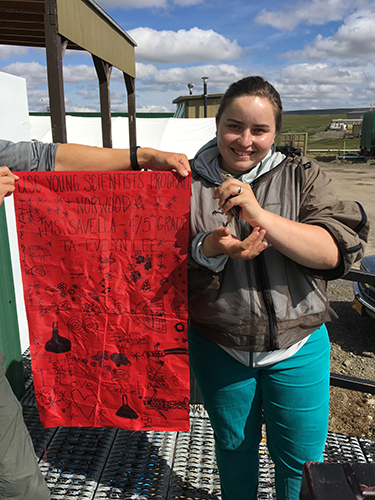 I'm holding a Gambel's white-crowned sparrow with a YSP Flag. Photo by DJ Kast
I'm holding a Gambel's white-crowned sparrow with a YSP Flag. Photo by DJ Kast

Comments